28.12.2018
NASA spacecraft readies for New Year’s rendezvous with primordial object far beyond Pluto
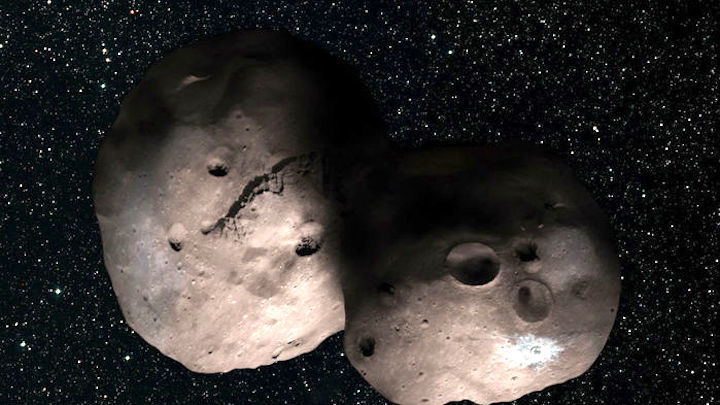
An artist’s depiction of MU69, also known as Ultima Thule, a solar system body about to be visited by the New Horizons spacecraft
NASA/JOHNS HOPKINS UNIVERSITY APPLIED PHYSICS LABORATORY/SOUTHWEST RESEARCH INSTITUTE/ALEX PARKER
LAUREL, MARYLAND—NASA’s New Horizons probe has racked up a list of accomplishments since its launch in 2006, traveling billions of kilometers and, in 2015, unveiling the atmosphere and surface of the dwarf planet Pluto during a rapid flyby. But in a few days, as Earth moves into a new year, New Horizons will attempt its trickiest feat of all: traveling back in time.
Just a tick after the clock strikes midnight on New Year’s Eve here at the Johns Hopkins University Applied Physics Laboratory (APL), which operates the spacecraft for NASA, New Horizons will race past MU69, a 35-kilometer-wide object some 6.6 billion kilometers away, in a far-off region of the solar system called the Kuiper belt. Unlike every other object previously visited by NASA spacecraft, MU69—or “Ultima Thule,” as it’s nicknamed, a classical term used for land beyond the known world—is expected to be unchanged since it formed billions of years ago, granting a window to the solar system’s earliest days. “No one’s ever been to this kind of object,” says Alan Stern, the mission’s principal investigator and a planetary scientist from the Southwest Research Institute’s (SwRI’s) Boulder, Colorado, office. “No one’s ever been to anything that has been so pristine and primordial.”
Until the early 1990s, scientists did not have evidence that this band of rocky bodies existed; it had only been theorized by researchers, including its namesake Gerard Kuiper. Since then, astronomers have discovered thousands of Kuiper belt objects past Neptune, with many more likely still unseen. Researchers have also discovered that this menagerie has a complicated structure, reflecting the solar system’s turbulent history. “I call it the solar system’s attic,” Stern says. Some of the belt’s objects, including Pluto, likely formed closer to the sun and were flung outward by gyrations of the giant planets. But others, like the relatively tiny MU69, likely formed where they are today, in languid circular orbits some 45 times farther than Earth is from the sun.
Visiting what astronomers refer to as a “cold classical” was part of New Horizons’s $800 million mission from the start. But finding one to visit proved trickier than expected. After its Pluto encounter, New Horizons is exiting the solar system by flying straight toward the center of the Milky Way, into a kaleidoscope of stars, making the discovery of a dark small object it could visit a challenge. Finally, the Hubble Telescope was able to locate five suitable candidates, with the New Horizons team choosing MU69 because they could reach it quickest and with the least fuel consumption, leaving future exploration options within the belt open—and not, they swear, for the holiday-themed arrival time. Indeed, the timing may turn out to be less than opportune for publicity given that NASA’s vaunted media operations, including its popular video channel, will likely remain dark during the encounter because of the U.S. government shutdown.
The flyby will be familiar to anyone who followed the spacecraft’s Pluto campaign. But now the spacecraft is older, its nuclear power source is waning, and it’s much farther away. The team is smaller and had less time to prepare, says Alice Bowman, the mission operation manager for New Horizons. “It’s a much quicker, much harder mission.” It now takes a signal from mission control at APL 6 hours to reach the spacecraft, requiring everything about the flyby to be even more carefully scripted than for Pluto. Earlier this month, New Horizons’s Telescope—essentially a camera with a telephoto lens—spent several weeks scouring the region around MU69, hunting for hazards, such as rings or moons. None seen, its science team opted for the closest approach, passing only 3500 kilometers away from its surface.
The flyby technically began on Christmas. Unlike Pluto, whose orbit has been precisely charted for a long time, MU69 was only discovered 4 years ago and its trajectory is not perfectly known. Because of this, the team has to rely on direct observation of the body, which for now still appears as little more than a pixel in its telescope, to understand its location relative to New Horizons. Until this weekend, the team is using the probe’s telescope to get a handle on the uncertainty of MU69’s location. Although it will be too late to tweak the spacecraft’s trajectory, the team will be able to rework the script of its high-resolution camera so that it can be certain of imaging MU69. This final update will then be relayed to New Horizons on 30 December.

The first detection of MU69 with the highest resolution of New Horizons telescope, taken on Christmas Eve
Even if the partial shutdown of the federal government, which includes NASA, continues into the new year, a festive atmosphere will reign at APL, which as a NASA contractor can continue its work, covering expenses from its own reserves. New Horizons will fly past MU69 at 12:33 a.m. Eastern Standard Time, shooting past at 14 kilometers per second, and it will take some 8 hours for the spacecraft’s first data to reach back to Earth, indicating its survival, along with a clutch of initial observations—The New York Times package, as Stern calls it. The first low-resolution image likely won’t come until late on New Year’s Day, with better imagery the day after. Don’t wait up.
Little is known about what New Horizons will see. “We don’t even have a betting pool going,” Stern says. Telescopes trained on MU69, from Hubble to ground-based facilities, have revealed that, like other cold classicals, it has a dark, reddish hue, along with what looks an oblong shape, possibly indicating a small binary object. That wouldn’t be unheard of—scientists believe a third of the objects in the Kuiper belt could be such binaries, a reflection of the calm conditions in which they formed. These observations have also been unable to tease out variations in the sunlight reflected off of MU69, which could normally be used to tease out its rotation. This could be thanks to an unusually fast or slow rotation; microscopic dust; MU69’s axis pointing directly toward Earth; or a small swarm of miniature moons.
MU69 will not have the complexity of Pluto’s surface; it lacks the gravity to sculpt its icy exterior. Indeed, it will likely look a bit boring, a dark anonymous lump in the solar system’s attic. But precisely because of its averageness, scientists hope it can inform their broader understanding of the Kuiper belt and beyond. “It’s got a lot to live up to,” says Anne Verbiscer, an astronomer at the University of Virginia in Charlottesville and assistant project scientist on the mission. “For a 35-kilometer body, that’s a lot to ask.”
Something as simple as counting the number of craters on its surface could hold vital clues, says Brett Gladman, an astronomer at the University of British Columbia in Vancouver, Canada. For example, Pluto and its moon had far fewer craters than expected, and there were fewer, smaller ones than expected. If MU69 shows a similar pattern, given the Kuiper belt’s primordial nature, Gladman says, “that means learning something directly about the sizes of the objects that the solar system originally formed out of.” Similarly, the craters could also inform just how much the migrations of the giant planets to their current orbits tossed the solar system around.
The composition of MU69 is also a mystery. It has to contain a lot of water ice, which is the primary building block of the outer solar system. But, like its cold classical siblings, it is dark with a reddish tint, not brilliantly white like icy moons such as Europa or Enceladus. “We don’t know what this red stuff is,” says John Spencer, a planetary scientist at SwRI and deputy project scientist on New Horizons. “We don’t know if it is telling us about the deep interior or just a paint job on the surface.” By peering into craters, New Horizons might catch a glimpse of MU69’s interior. And it could be rockier than expected, as a recent astronomical campaign focused on the Kuiper belt object hinted, says Wesley Fraser, an astronomer at Queen’s University Belfast. “I expect rock with ice embedded. That’s my theory.”
Scientists also have high hopes for MU69’s surface. There’s a growing theory that planetary building blocks don’t form, or accrete, like a car plowing through a cloud of bugs, Fraser says. Instead, evidence suggests turbulence clumps particles together in a cloud, which then gravitationally collapses into a binary or trinary mass. “If it did evolve from a cloud of particles, we should see those actual particles on the surface of MU69,” Fraser says. “It should be a clump of pebbles stuck together.”
Although the MU69 flyby will garner the headlines, it remains an N of 1 representing a large population. So New Horizons, before and after the flyby, has turned itself into a remote observatory, using its telescope to examine two dozen similar Kuiper belt objects. These observations benefit from their angle. Telescopes on Earth, and around it, can only see the Kuiper belt with the sun beaming at it head-on. New Horizons can observe these bodies at a different angle and, much like how the bright green of a field of grass becomes mottled when its blades cast shadows on one another, that can reveal the texture and material of a surface. “It will tell us if Ultima is typical of its neighbors or if it’s some kind of oddball,” Spencer says.
In a few days, many mysteries should be resolved—and even more will likely be generated, Fraser says. “Let’s be honest, no one expected Pluto to look like it did. MU69 is going to be exactly the same way.” Like the Pluto visit, too, New Horizons will take a while to beam all of its data back, some 20 months, Stern adds. But there’s time. After all, he says, “nobody else is coming this way anytime soon.”
Quelle: Science
+++
A NASA space probe is about to snap pictures of a mystery object beyond Pluto
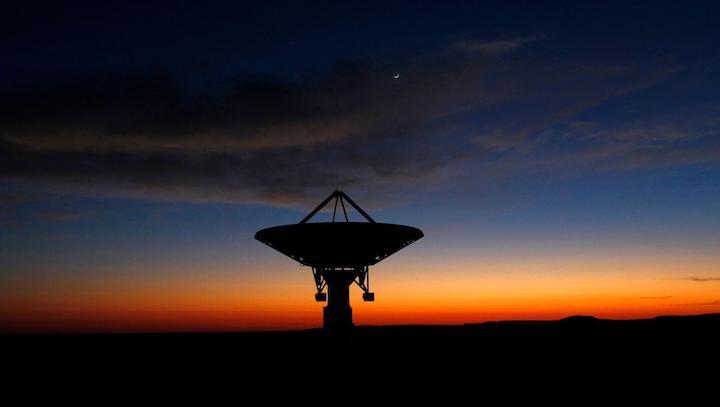
It gave earthlings our first close-up images of Pluto. Now, just three-and-a-half years later, NASA’s New Horizons spacecraft is closing in on a mysterious hunk of reddish rock and ice that’s inspired much fascination within the astronomy community.
Even the object’s name—Ultima Thule—reveals just how little we know about the floating mass. It literally translates to “beyond the known world.”
“This is pure exploration,” said Alan Stern, the mission’s principal investigator in a statement. “We are really flying toward something completely unknown, unlike any other object we’ve studied in the past.”
According to NASA, the hunk stretches about 20 miles (32 kilometers) across, and it’s significant to space scientists because it is potentially the most primitive object ever encountered by a spacecraft. Astronomers see this as an opportunity to check out something that scientists say could be as as old as the moments when the solar system’s planets were first forming.
Ultima Thule is located in a region of space at the edge of the solar system called the Kuiper Belt. It’s mostly home to hundreds of thousands of asteroids and comet-like objects.
The New Horizons spacecraft, which is about the size of a baby grand piano, is set to reach Ultima Thule on Jan. 1 at 12:30am EST. Images are expected to transmit 4 billion miles back to earth by 10am.
The images of Ultima Thule are really just an encore performance from the New Horizons spacecraft, which was dispatched from Earth to snap images of Pluto. But scientists say the craft still has enough power to keep it traveling through space through the mid-2030s. So they intend to send it further into the Kuiper Belt, where it’ll give new close-up insights into regions of space we’ve never seen before.
Quelle: JHUAPL
----
Update: 31.12.2018
.
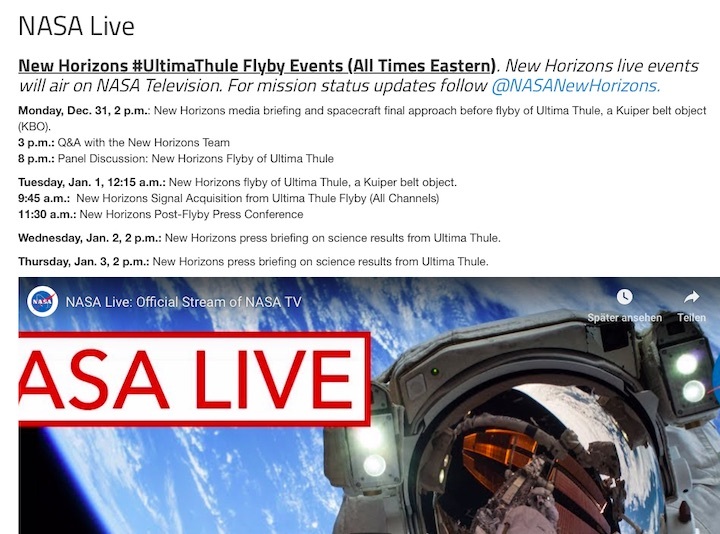
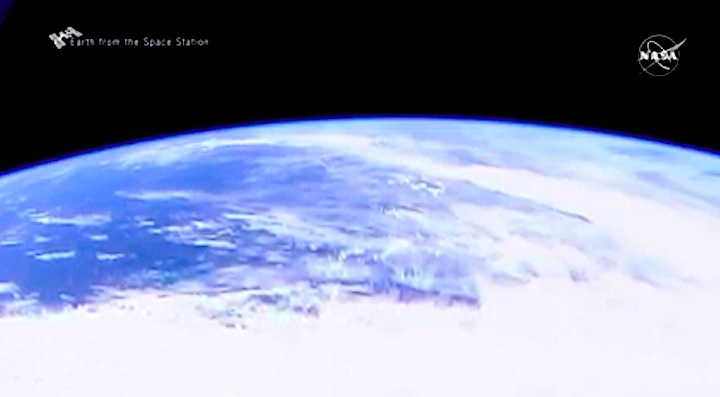
Quelle: NASA
+++
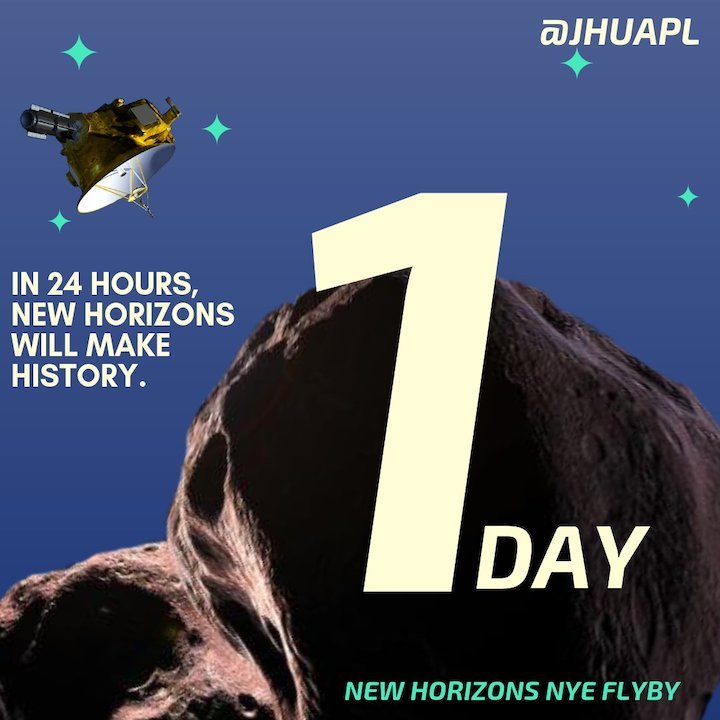
Quelle: JHUAPL
----
Update: 1.01.2019
.
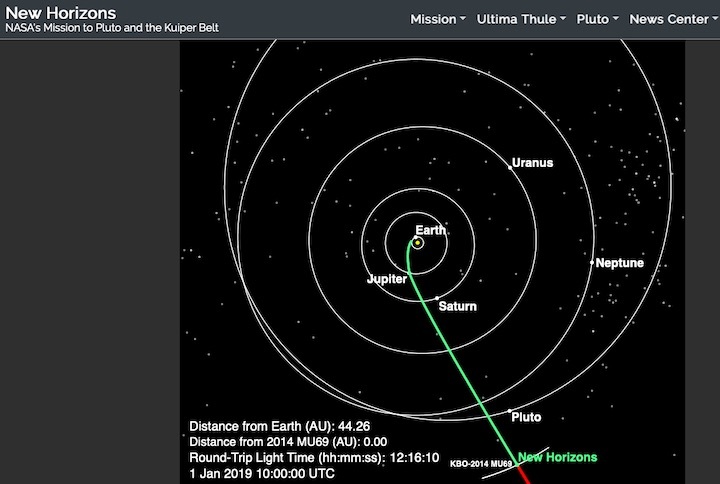
December 31, 2018From the Associate Administrator: Go New Horizons!
In just a handful of hours, NASA's New Horizons spacecraft will perform the furthest encounter of an object in our solar system. On Jan. 1 at 12:33 a.m., New Horizons is set to fly by 2014 MU69, nicknamed Ultima Thule, and collect images and scientific data to beam back to Earth. Ultima orbits the Sun from a vast region of icy and rocky bodies beyond the orbit of Neptune. Studying this primitive world—which has been around, unaltered, since the beginning of the solar system—will provide us with vital insights into the origins and evolution of our celestial neighborhood.
Below is a message from Thomas Zurbuchen, the associate administrator of NASA's Science Missions Directorate, to Alan Stern, New Horizons principal investigator of the Southwest Research Institute in Boulder, Colorado.
Alan – as you know, we are on [government] shutdown, and I am unable to contribute to this historic event like I intended to. I will be sure to be there as a guest with my family! Here is why.
I think it is fitting that this Ultima Thule [flyby] is at the interface of the 60th anniversary of Explorer 1 in 2018 and the 50th of Apollo 11 in 2019. To me, this milestone of New Horizons is full of everything NASA and NASA Science is all about. It is about boundless aspiration and hope that are at the inception of exploration. It is about innovation and perseverance to actually create the success, by an amazing team that transcends what is reasonably expected or even what seems possible initially. And then, it is about surprise and transformative learning that has been at the heart of NASA and NASA Science and Exploration during the past 5-6 decades. The Ultima Thule flyby has all of these!
For all of that, I wish you and the team the best of luck! We at NASA Science are incredibly proud of you and your team - both the science and engineering teams – and can't wait for the surprises that will be uncovered during the next hours and days.
Go New Horizons! Go Ultima Thule!
Go Exploration – Forever!
Thomas
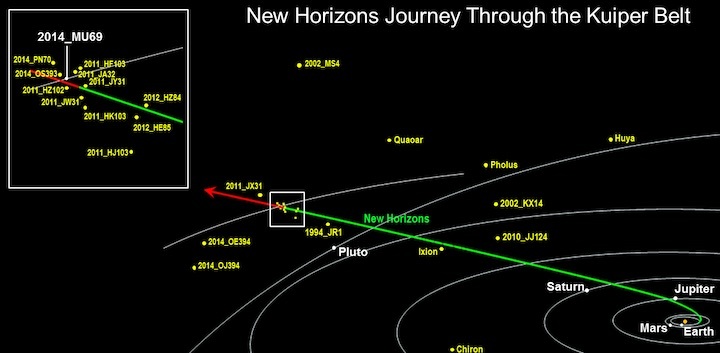
Quelle: NASA
+++
